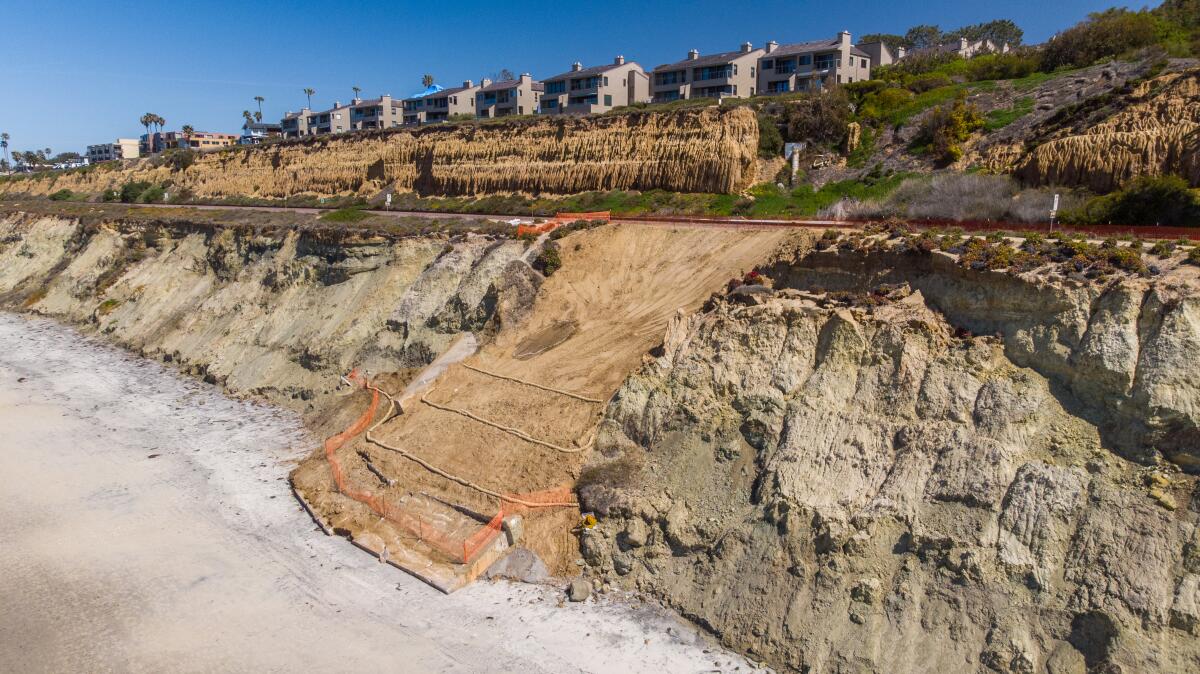Construction begins on sea wall to protect train tracks in Del Mar

- Share via
SAN DIEGO — Construction begins this month on a nearly 300-foot-long sea wall to protect the coastal bluffs below the heavily traveled railroad tracks in Del Mar.
The sea wall is the final stage of $11 million in emergency repairs needed to safeguard the tracks after a wide portion of the bluff collapsed in late February. The slide came within 35 feet of the railroad ties on the only train route between San Diego and Los Angeles and the rest of the West Coast.
Earlier work focused on regrading the slope, which is 50 to 70 feet high, and installing about 18 concrete-and-steel piles up to 60 feet deep at the upper level near the track. Train speeds were reduced for safety through the area for months, and all rail service was suspended on several weekends to complete the work done so far.
“Stabilizing the Del Mar bluffs is crucial to ensuring safe and reliable rail operations and creating a faster, fairer, cleaner transportation system,” said Encinitas Mayor Catherine Blakespear, who chairs the board of the San Diego Assn. of Governments.
All coastal development, including sea walls, retaining walls and other bluff protection structures, require the approval of the California Coastal Commission. Generally, the commission opposes sea walls because they restrict public access to the beach and can contribute to coastal erosion. The commission makes exceptions, however, for emergency repairs to protect vital infrastructure such as the railroad.
In cases such as the Del Mar bluff collapse, the commission allows the governments association and other local agencies to begin repairs immediately and seek approvals later.
That was the case when a powerful winter storm over the 2019 Thanksgiving weekend caused significant bluff erosion near the tracks in Del Mar. Over the next few weeks, the association removed loose material from the steep slope and installed reinforcement piles and a steel-plate retaining wall, then backfilled the area with concrete slurry.
“The emergency repair work was necessary to protect the railroad track bed and public safety, and is similar to previous upper bluff stabilization projects the commission has reviewed and approved on the Del Mar bluffs,” Coastal Commission staffers said when the completed repairs were approved on Aug. 12, 2020.
The emergency work this year has been more extensive but is expected to conclude with the sea wall.
Beachgoers in the area should be cautious to avoid construction zones for the next few weeks, officials say. The job will include placing more concrete-and-steel piles at beach level, then placing wooden beams between them to form the sea wall. The structure is designed to protect the base of the bluffs from erosion caused by waves and sea level rise.
Typical work hours are expected to be 7 a.m. to 7 p.m. Mondays through Fridays, depending on tides and surf, continuing through the fall. Crews will use the North Torrey Pines State Beach parking lot as a staging area for heavy equipment, and flaggers will be present to direct vehicles to and from the work area.
Long-term plan calls for moving the railroad off the bluff and onto a new route through a tunnel beneath Del Mar. That solution is expected to cost several billion dollars and take decades to complete, but in recent months agencies including the San Diego Assn. of Governments and the North County Transit District have made moves to expedite planning for the route.
The regional planning agency has overseen four stabilization projects since 2003 to preserve the 1.7 miles of track on the bluffs. The fourth phase of that work ended in January, shortly before the collapse that led to the ongoing emergency repairs.
Two new studies released by the governments association in August emphasized the need to control storm-water runoff in Del Mar to slow the erosion of the upper levels of the bluffs.
“Damage to the rail corridor as a result of concentrated flow not being contained by existing drainage systems and flowing uncontrolled onto the railroad right-of-way has been significant in the last few years,” states a drainage study prepared for the association by the consulting firm HNTB of San Diego in June.
Commercial buildings, homes and other development built on hillsides near the beach have covered more ground and increased the peak runoff during storms, the study says. The storm drains are too small to contain the peak flow, and water runs across streets and properties toward the beach over the railroad right of way, causing more erosion.
The study recommends 15 drainage system improvements to be included in the next round of work, the fifth phase of the long-term stabilization efforts, scheduled to begin in 2023. Those improvements include the replacement of larger storm drains along some roads in Del Mar and new connections to channels and outlets to the beach.
The sixth and final phase of Del Mar stabilization projects is intended to keep the bluffs safe for train travel until the alternative route through a tunnel can be completed.
North County Transit District commuter trains, Amtrak passenger service and BNSF Railway freight trains all travel the Del Mar bluffs as part of the coastal rail corridor, one of the busiest in the United States. The route had 44 passenger trains and six freight trains daily in 2019, before the COVID-19 pandemic reduced service in 2020.
Rail traffic is expected to increase to 78 passenger trains and 22 freight trains daily by 2030, according to the San Diego Assn. of Governments.
More to Read
Sign up for Essential California
The most important California stories and recommendations in your inbox every morning.
You may occasionally receive promotional content from the Los Angeles Times.











